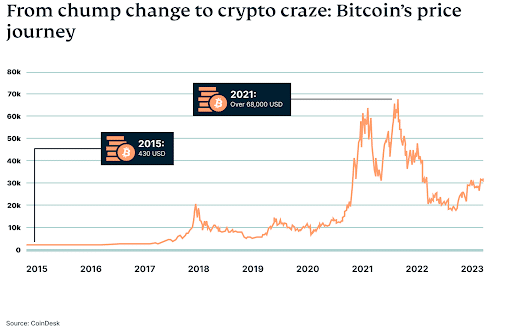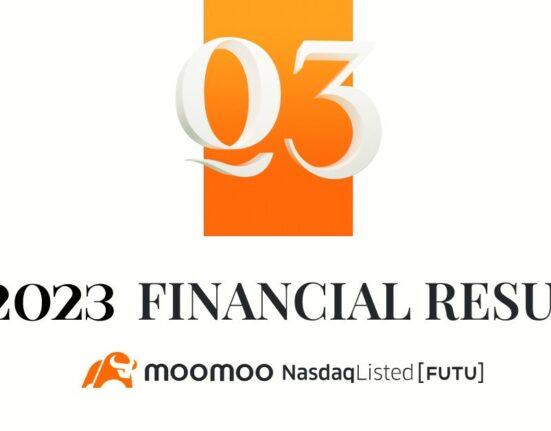Digital assets span far beyond bitcoin and NFTs.
Allison Saeng on Unsplash
Next year will mark fifteen years since the launch of Bitcoin, and the original cryptocurrency has had a rather wild ride in that time, much like the entire digital assets industry itself. It only crossed the $1 value two years after it launched, which is hard to imagine considering its peak value of over $68,000 just a few years ago.
At the end of an inauspicious year that brought us the rapid demise of NFT valuations, a guilty verdict and potential 110-year prison sentence for the former CEO of one of the top three largest cryptocurrency exchanges and a guilty admission, $4.3 billion in fines and resignation from the CEO at the largest cryptocurrency exchange, it’s surprising to see the original cryptocurrency is sitting at a current eighteen month high of over $39,000.
But there has simultaneously been a significant amount of evolution that also occurred in the digital assets industry during this time, and looked at from a broader perspective, there is certainly a fair point that like any rapidly developed ecosystem it will need to be shaped by some of its failures on its way towards mass adoption.
Finding Mainstream Utility
“The current state of the crypto market is one of transition,” says Coindesk’s Todd Groth, who is Head of Index Research at CoinDesk Indices, adding the explanation, “The leverage and excesses of the previous market cycle have been mostly cleared and new products push towards developing greater real-world utility and catering towards regulated institutional investors.“
One of the more trusted crypto media and data providers, Coindesk made the news itself recently after being acquired by Bullish, a regulated and audited crypto exchange. Run by former New York Stock Exchange President, Tom Farley, Bullish was created with the long-term institutionalization of digital assets in mind, something that Groth believes is in gaining rapid momentum.
“This institutional ‘coming of age’ for the market comes alongside a good year of Bitcoin and Ethereum performance, despite the ending stages of a U.S. interest rate hiking cycle,” says Groth, adding that, “The performance during the bond bear market helps support the narrative of Bitcoin and Ethereum as real assets, similar to digital gold and oil respectively.”
The acquisition puts Coindesk on a good path but also sends a message of optimism to companies that provide digital assets solutions to investors. Benaiah Capital is a boutique investment firm that focuses exclusively on digital assets and emerging blockchain technology, and CEO Ben Wiener believes activity like the Coindesk acquisition benefits the entire market.
“Additional investment has a multiplying effect as it recruits top talent which further expands the space and queues up the next round of investment,” Wiener notes, adding, “I’m optimistic that this will lead to improved coverage, analysis, and education about digital assets.”
Certainly necessary in an evolving space like digital assets, and no doubt useful to Benaiah, which Wiener notes takes an educational approach first and spends a significant amount of resources keeping their family office clients updated on the shifting market.
“We’ve witnessed a notable shift in sentiment among family offices in the last 6 months,” he adds, “Many of them have moved from cautious observers to actively exploring and investing in this space, which suggests it’s highly likely to continue into 2024.”
Easier Access, Tighter Regulations
Something destined to make headlines in the new year and perhaps behind some of the current increasing value in Bitcoin is the impending January approval of spot Bitcoin Exchange Traded Funds. Another step towards accessibility to the digital asset pool for institutional investors and sure to see large amount of capital deployed, it does come with some in the industry cautioning that it could result in lesser-established cryptocurrencies slipping further off the radar, and the potential for a sudden dip in valuation on the day of launch.
As part of the institutionalization, a more solid framework of regulations is emerging which looks set to address some of the volatility and cautious sentiment. This might also help prevent some of the recent turmoil and scandals related to exchanges such as FTX and more recently Binance.
Wiener believes this may be the transformation that digital assets need to shed the often speculative perception, and should open the market to new investors. “In 2024 we anticipate a maturation of the market with clearer regulations and a broader range of investment options,” Wiener says, “This belief in shift is one of the reasons we’re seeing family offices starting to become so active in the space, as their confidence increases as a result.”
Cross-Functional Products
One of those broader range of investment options and a contributing factor to confidence is the growth in secure tokens and specifically stablecoins. The market for stablecoins, cryptocurrencies that are pegged to another asset, commonly a traditional fiat currency, is expected to grow. As their unique structure offers the benefits of decentralized digital assets with the largely greater stability of traditional currency, they offer a gateway of sort to those looking to explore digital assets.
PayPal just released PYUSD stablecoin just over three months ago, which instantly made it available for individuals using their payment service as well as their network of over 29 million merchants the ability to transact using their stablecoin. Pegged to the Dollar and issued on Ethereum blockchain, it will be interesting to observe how it trades over the next year, though it’s far from the first established financial services company to release a stablecoin: JPMorgan’s JPM Coin has been in use since 2019 and handles over $1 billion of transactions daily.
Further Digitization
While the hype around Non-Fungible Tokens (NFT) definitely dropped hard this year, with many collectible tokens reduced to zero value. But tokenization as a whole still offers huge potential, a potentially $10 trillion market by the end of the decade. The integrating of real assets into the digital asset space, through tokenized shares, real estate, art and other assets creates new levels of liquidity and ownership opportunities previously unavailable – that is if the market-hindering lack of trust for tokens can progress.
The year ahead will also see investment opportunities on the legal side, as smart contracts that use blockchain technology explore how to reduce costs and simplify some the elements of financial, real estate and other complex transactional agreements. There are a number of startups exploring smart contract management platforms, an exciting addition to the digital asset space.
A Sleeping Bull?
While the digital asset market is certainly more mainstream than it has been before, at this point many assets are still speculative and volatile, and with regulatory efforts imminent but not yet clearly framed it, the year ahead for the market is expected to be positive but undoubtedly with a few surprises thrown in given the rate of evolution.
“The speed at which this market is about to move and the impact it will have will resemble what we witnessed with the internet,” says the Benaiah CEO when asked about how he believes family offices should view the market.
No doubt family offices need to work with experienced industry advisors in order to take advantage of the many opportunities the current digital asset market presents, while dealing with the unique compliance challenges they face and balancing their ever-present generational wealth preservation goals.







